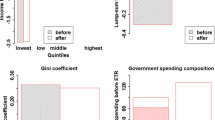Abstract
We augment the Stokey (1998) model by allowingagents to differ with respect to environmentalquality and income in order to analyze theimpact of income and environmental inequality,and of democratization on aggregate pollution.We find that the impact of a more equal incomedistribution depends on the degree ofdemocracy. In a complete democracy a more equalincome distribution generates, ceterisparibus, less pollution, which is consistentwith indirect empirical evidence, whereas theopposite is the case if democratic rights arehighly restricted. Furthermore, ademocratization is argued to typically lowerboth the income and the environmental qualityof the median voter. In this case, if, inutility terms, the fall in environmentalquality is worse than the fall in consumptionthe median voter decides to tightenenvironmental legislation so that aggregatepollution decreases.
Similar content being viewed by others
References
Acemoglu, D. and J. A. Robinson (2000), ‘Why Did the West Extend the Franchise? Democracy, Inequality and Growth in Historical Perspective’, Quarterly Journal of Economics 115, 1167-1199.
Andreoni, J. and A. Levinson (2001), ‘The Simple Analytics of the Environmental Kuznets Curve’, Journal of Public Economics 80, 269-286.
Ansuategi, A. and C. Perrings (2000), ‘Transboundary Externalities in the Environmental Transition Hypothesis’, Environmental and Resource Economics 17, 353-373.
Arrow, K. J. et al. (1995), ‘Economic Growth; Carrying Capacity, and the Environment’, Science 268, 520-521.
Carlsson, F. and S. Lundström (2002), Political and Economic Freedom and the Environment: The Case of CO 2 Emissions, mimeo. Department of Economics, Göteborg University.
Deininger, K. and L. Squire (1996), ‘A New Data Set Measuring Income Inequality’, World Bank Economic Review 10(3): 565-591.
Dollar, D. and A. Kraay (2001), Growth Is Good for the Poor. Working Paper, The World Bank.
Ekins, P. (1997), ‘The Kuznets Curve for the Environment and Economic Growth: Examining the Evidence’, Environment and Planning A 29, 805-830.
Gottschalk, P. and T. M. Smeeding (2000), ‘Empirical Evidence on Income Inequality in Industrialized Countries’, in A. B. Atkinson and F. Bourguignon, eds., Handbook of Income Distribution, Volume 1, (pp. 261-307). Amsterdam: North-Holland.
Grossman, G. M. and A. B. Krueger (1993), ‘Environmental Impacts of a North American Free Trade Agreement’, in P. Garber, ed., The US-Mexico Free Trade Agreement (pp. 165-177). Cambridge, MA: MIT Press.
Grossman, G. M. and A. B. Krueger (1995), ‘Economic Growth and the Environment’, Quarterly Journal of Economics 110, 353-377.
Hahm, J. H. (1998), ‘Consumption Adjustment to Real Interest Rates: Intertemporal Substitution Revisited’, Journal of Economic Dynamics and Control 22, 293-320.
Hall, R. E. (1988), ‘Intertemporal Substitution in Consumption’, Journal of Political Economy 96, 339-357.
Harbaugh, W., A. Levinson and D. Wilson (2002), ‘Reexamining the Empirical Evidence for an Environmental Kuznets Curve’, Review of Economics and Statistics 84(3), 541-551.
Hettige, H., R. E. B. Lucas and D. Wheeler (1992), ‘The Toxic Intensity of Industrial Production: Global Patterns, Trends and Trade Policy’, American Economic Review 82(2), 478-481.
Holtz-Eakin, D. and T. M. Selden (1995), ‘Stoking the Fires? Emissions and Economic Growth’, Journal of Public Economics 57, 85-101.
John, A. and R. Pecchenino (1994), ‘An Overlapping Generations Model of Growth and the Environment’, The Economic Journal 104 (November), 1393-1410.
Jones, L. E. and R. E. Manuelli (2001), ‘Endogenous Policy Choice: The Case of Pollution and Growth’, Review of Economic Dynamics 4, 369-405.
Kaitala, V., K.-G. Mäler and H. Tulkens (1995), ‘The Acid Rain Game as a Resource Allocation Process with an Application to the International Cooperation among Finland, Russia and Estonia’, Scandinavian Journal of Economics 97(2), 325-343.
Kuznets, S. (1955), ‘Economic Growth and Income Inequality’, American Economic Review 45(1), 1-28.
López, R. (1994), ‘The Environment as a Factor of Production: The Effects of Economic Growth and Trade Liberalization’, Journal of Environmental Economics and Management 27, 163-184.
Marsiliani, L. and T. I. Renström (2000), Inequality, Environmental Protection and Growth, mimeo. CentER, Tilburg University.
Morrisson, C. (2000), ‘Historical Perspectives on Income Distribution: The Case of Europe’, in A. B. Atkinson and F. Bourguignon, eds., Handbook of Income Distribution, Volume 1 (pp. 217-260). Amsterdam: North-Holland.
Perman, R., Y. Ma, J. McGilvray and M. Common (1999), Natural Resource and Environmental Economics, Second Edition. Essex: Addison Wesley Longman.
Persson, T. (1998), ‘Economic Policy and Special Interest Politics’, The Economic Journal 108 (March), 1-18.
Selden, T. M. and D. Song (1994), ‘Environmental Quality and Development: Is There a Kuznets Curve for Air Pollution Emissions?’, Journal of Environmental Economics and Management 27, 147-162.
Stokey, N. L. (1998), ‘Are There Limits to Growth?’, International Economic Review 39, 1-31.
Vogel, M. P. (1999), Environmental Kuznets Curves. A Study on the Economic Theory and Political Economy of Environmental Quality Improvements in the Course of Economic Growth. Berlin: Springer.
von Amsberg, J. (1995), ‘Excessive Environmental Risks: An Intergenerational Market Failure’, European Economic Review 39, 1447-1464.
World Bank (1992), World Development Report 1992: Development and The Environment. Oxford: Oxford University Press.
Author information
Authors and Affiliations
Rights and permissions
About this article
Cite this article
Eriksson, C., Persson, J. Economic Growth, Inequality, Democratization, and the Environment. Environmental and Resource Economics 25, 1–16 (2003). https://doi.org/10.1023/A:1023658725021
Issue Date:
DOI: https://doi.org/10.1023/A:1023658725021




